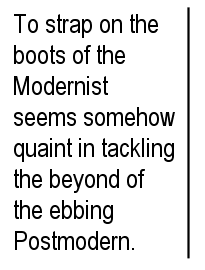
Technology and the PostmodernPostmodernism in the Age of Digital ReproductionIt is surprising how many times Benjamin refers to 'reproduction' and not to creation. Artists make things. Reproduction in human terms is creation. Musique concrete, Raushenberg transfers, Xerox art, minimalism all are dependent on reproduction in terms of creation. For the artist who makes work that is meant specifically to be reproduced, the reproduction is the art itself, and any of the reproductions are seen as valid representations of the work itself. The paradigm shifted long before Postmodern theory. Questions of totality, hyper-relations and difference exist at any age. The fact that they may refute each other chips at the edifice of a coherent Postmodern doctrine, much as contemporaneous and succeeding Modernist theories contradicted each other. The reactionary Postmodern is to some measure absorbed by Modern, as each becomes a reflection of the other, with Postmodernism having the benefit of coming later. A force or recognition, most often from outside the theoretical, is necessary to jar work into the next era. It takes the dream of technological advance and the advances themselves: writing, the press, musical instruments with extended ranges, faster mechanisms and better projected sound, mechanical reproduction, digital reproduction to further our collective vision and to impress on the individual the capacity for what yet might be.
We have gone beyond Modern and Postmodern
with the computer.
But people still debate Benjamin's conservative
attack on the withering of the aura and his version of the Modernist
Benjamin notes, 'to an ever greater degree the work of art reproduced becomes the work of art designed for reproducibility.' Finally he hits it... in 1935 this is brilliant and correct, except that he sees it as a crisis rather than as a release and potential for widening experience authentically. Though by no means egalitarian at this point, the internet and digital communication and reproduction will increasingly find their way into the lives of those in the lower economic strata (recent figures have shown that age and level of education, not econonic status - though related, are the main determinants of computer usage). Earlier we witnessed a similar increasing appeal with television. Some find it tempting to choose a fatalistic prediction, one based similarly to that of some Postmodern thought, that it has been done before: all we may do is self-consciously manipulate the preceding models. That would be an unconscionable waste and a shame.
Copyright © 27 February 2000 Jeff Talman, Saratoga Springs, NY, USA
|

 sensibility (one which you would think a real Modernist would
find intriguing...), yet to strap on the boots of the Modernist
seems somehow quaint in tackling the beyond of the ebbing Postmodern.
Architecture helps to point the way... the size and radical design
of much new work speaks heaps beyond the extremely conservative
Postmodern architecture of the 80's and 90's. Frank Gehry's computer-aided
design would not have been possible until the digital age had
arrived. The curvilinear forms: new, powerful, ubiquitous in design
already (though often sensational, ostentatious and tasteless)
will eventually find integration, assimilation and balance.
sensibility (one which you would think a real Modernist would
find intriguing...), yet to strap on the boots of the Modernist
seems somehow quaint in tackling the beyond of the ebbing Postmodern.
Architecture helps to point the way... the size and radical design
of much new work speaks heaps beyond the extremely conservative
Postmodern architecture of the 80's and 90's. Frank Gehry's computer-aided
design would not have been possible until the digital age had
arrived. The curvilinear forms: new, powerful, ubiquitous in design
already (though often sensational, ostentatious and tasteless)
will eventually find integration, assimilation and balance.